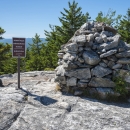Visit Us
National wildlife refuges offer us all a chance to unplug from the stresses of daily life and reconnect with our natural surroundings. Many people visit Wapack NWR to hike its four trails, including a four mile section of the 21-mile Wapack Trail, a spur of the Appalachian Trail. Wapack Trail passes over the top of North Pack Monadnock and offers outstanding opportunities for viewing migratory hawks and a beautiful view of the surrounding mountains.
Location and Contact Information
What We Do
Wildlife conservation is at the heart of the National Wildlife Refuge System. It drives everything on U.S. Fish and Wildlife Service lands and waters managed within the Refuge System, from the purposes for which a national wildlife refuge national wildlife refuge
A national wildlife refuge is typically a contiguous area of land and water managed by the U.S. Fish and Wildlife Service for the conservation and, where appropriate, restoration of fish, wildlife and plant resources and their habitats for the benefit of present and future generations of Americans.
Learn more about national wildlife refuge is established to the recreational activities offered to the resource management tools used. Using conservation best practices, the Refuge System manages Service lands and waters to help ensure the survival of native wildlife species.
Our Species
The refuge is a popular hawk migration area and provides nesting habitat for numerous migratory songbirds such as the tree sparrow, Swainson's thrush, magnolia warbler, crossbills, pine grosbeaks and white-throated sparrow. The refuge also supports a wide variety of upland wildlife including deer, bear, coyote, fisher, fox, mink and weasel.
Get Involved
Whether you want to further conservation, learn more about nature or share your love of the outdoors, you’ve come to the right place. National wildlife refuges provide many opportunities for you to help your community and fish and wildlife by doing what you love.

